May 24, 2025 | 16:19 GMT +7
May 24, 2025 | 16:19 GMT +7
Hotline: 0913.378.918
May 24, 2025 | 16:19 GMT +7
Hotline: 0913.378.918
Hon Khoai Island is located in the southwest sea in Tan An commune (Ngoc Hien district, Ca Mau province) at an altitude of 318m above sea level, nearly 15km from the nearest mainland point, near the international maritime route which is also the eastern gate way to the Gulf of Thailand. Hon Khoai is considered a forward station guarding the airspace and land in the southwest of the country.
Legend has it that the island is called Hon Khoai because from far distance, the island looks like a giant potato, so it was given that name. There are also people who think that because in the past, people on the shore went to the island to farm, and nowadays there are still potato bushes on the island, so it is called Hon Khoai island.
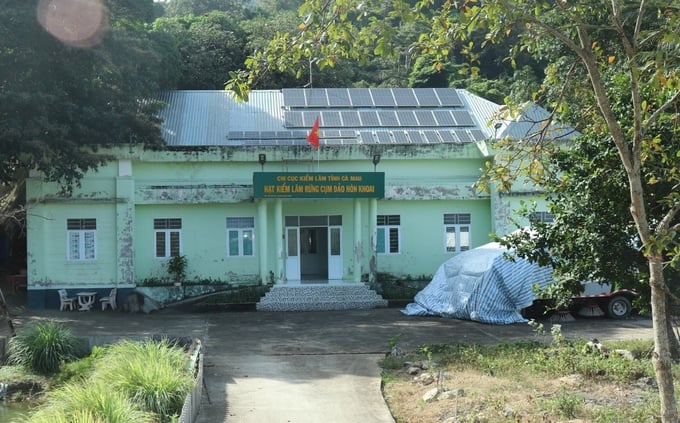
Headquarters of the Forest Ranger Department of Hon Khoai island cluster. Photo: Mai Phuong.
Although the name of the island is not very beautiful, Hon Khoai is said to be the most beautiful island in the southernmost region of the country, because it still retains the pristine beauty of the forest in the middle of the sea. Considering that there is no population on the island, Hon Khoai is still covered throughout the island with vast green forests with many large trees.
According to Mr. Huynh Tuan Kiet, the District Head of the Forest Ranger Department of Hon Khoai island cluster, which includes Hon Tuong, Hon Sao, Hon Doi Moi and Hon Da Le, of which Hon Khoai is the largest island with the forest area of 570 hectares. If included the forest area of Hon Chuoi island in cluster 1, Song Doc town (Tran Van Thoi district) of 140 hectares also managed by this department, then the total forest area that the Hon Khoai forest ranger department manages and protects is 701 hectares.
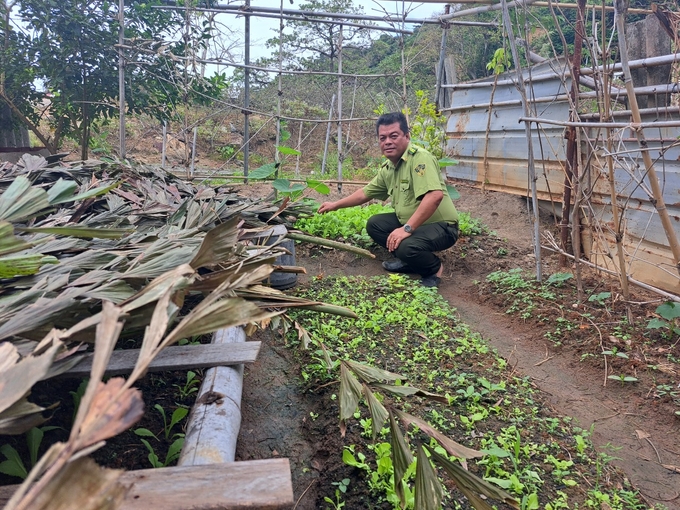
Mr. Huynh Tuan Kiet, the District Head of the Forest Ranger Department of Hon Khoai island cluster, takes care of the vegetable garden to improve life. Photo: Mai Phuong.
The forest on Hon Khoai island has a very rich flora with more than 1,400 species and many types of trees with high economic value; among them, timber trees include ironwood, linden, myrobalan, etc., resin oil, cassia, rhodiola, gold fruit plants, canarium, Chinese white olives... Medicinal trees vary widely from large bones and large leaves to broken bone with small leaves, as well as pericampylus incanus, dragon's blood, yam, umbrella plant, cassia, neem, gulbel, snake vine plants,...
“The forest on Hon Khoai Island is also responsible for protecting rare animals such as: yellow-tailed geckos, wild boars, monkeys, monitor lizards, reticulated pythons... Hon Khoai Island has no population, far from the mainland, only four units are stationed on duty: forest rangers, border guards, navy and lighthouse, so there is no situation of hunting rare animals like forests on the mainland," said Mr. Huynh Tuan Kiet, the District Head of the Forest Ranger Department of Hon Khoai island cluster.
Also according to Mr. Kiet, in the past, the forest of Hon Khoai island was occasionally secretly cut down by fishermen to repair boats, but was not extensively exploited by loggers like on the mainland; partly because the 4 forces stationed on the island regularly coordinate to patrol and protect the forest, partly also because the nearest point to the mainland is nearly 15km by sea, so if there is exploitation, it is difficult to transport smuggled wood back to mainland for consumption, and now there is almost absolutely no more logging.
Currently, the force of the Forest Ranger Department of Hon Khoai island cluster has 7 people, 1 district head, 1 district deputy chief and 5 staff and 1 patrol boat. Patrol boat can operate in level 7 and level 8 storms. Forest rangers regularly coordinate with border guards, navy and lighthouses to organize patrols to protect and prevent forest fires, especially is during the dry season.
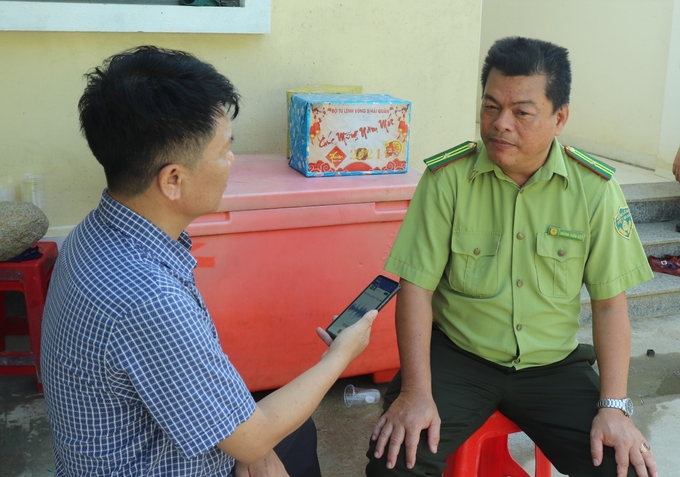
Mr. Huynh Tuan Kiet, the District Head of the Forest Ranger Department of Hon Khoai island cluster, talked to reporters. Photo: Mai Phuong.
According to scientists, there is not much biodiversity on Hon Khoai Island, but considering the level of individual diversity, it is very large. Currently on Hon Khoai Island, although there are few species living, the number of individuals in each species is very large, so the living population of these species can be maintained. Especially the yellow-legged lizard, an endemic reptile of Hon Khoai island. This is a lizard species that only appears in Hon Khoai, and can not be found anywhere else in the world.
“The special role of the forest of Hon Khoai island is to protect and nurture rare animals. The forest here is isolated, far from residential areas, so there is no hunting of wild animals like on the mainland," said Mr. Huynh Tuan Kiet, the District Head of the Forest Ranger Department of Hon Khoai island cluster.
The biggest worry of the authorities and units stationed on Hon Khoai island is forest fires. The dry season here is very harsh, prolonged heat causes forest trees to lose their leaves, and the risk of forest fires is at the highest level. Therefore, before the Lunar New Year, the forest rangers and units stationed on Hon Khoai island devoted their efforts to forest fire prevention and fighting.
According to Mr. Huynh Tuan Kiet, the District Head of the Forest Ranger Department of Hon Khoai island cluster, during the year, 4 units stationed on the island including rangers, navy, border guards and lighthouses assigned each specific forest location to manage and proactively patrol and protect forests, especially forest fire prevention. The regular task of the authorities on Hon Khoai island is to propagate to units coming to the island that when entering the forest for construction they must not cook and smoke, in order to prevent forest fires. Another specific task is to prevent fishermen when going to the island to rest from using fire to ensure forest safety on the island.
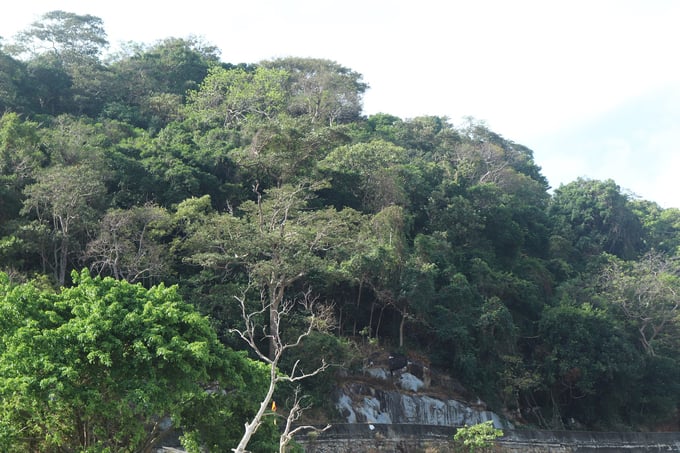
The special role of the forest of Hon Khoai island is to protect and nurture rare animals. Photo: Mai Phuong.
"The forest on Hon Khoai island is even more threatened when during the dry season the water in the streams dries up, and even more critically, the amount of water stored in the two reservoirs is also evaporated by the hot sun," Mr. Huynh Tuan Kiet shared.
Only when people went to the forests on Hon Khoai island did they see that forest fire prevention here received special attention, with forest fire warning signs everywhere. Furthermore, the authorities on the island are also interested in arranging fire-fighting equipment in places with high fire risk to respond promptly when a fire occurs. Roads leading into the forest are also cleared of vegetation to limit flammable materials.
Also according to Mr. Kiet, in the dry season, the forest rangers on the island coordinate with three units of the navy, lighthouse and border guard, from patrolling the forests on the island to getting on ships to patrol the forests at the foot of the island, especially forest fire prevention. Every year, around October and November of the previous year, the functional forces and units stationed on the island make plans to prevent and fight forest fires, and from January to May of the following year is the peak of forest fires prevention.
“Therefore, before Tet, the forest rangers on the island will devote all their forces to forest fire prevention and fighting. Near Tet, we divided into 2 shifts, 1 shift from December 28 to January 2, and 1 shift from January 2 to 6. January according to the Lunar calender. After Tet, the forest rangers on the island put all their forces into forest fire prevention work," said Mr. Huynh Tuan Kiet, the District Head of the Forest Ranger Department of Hon Khoai island cluster.
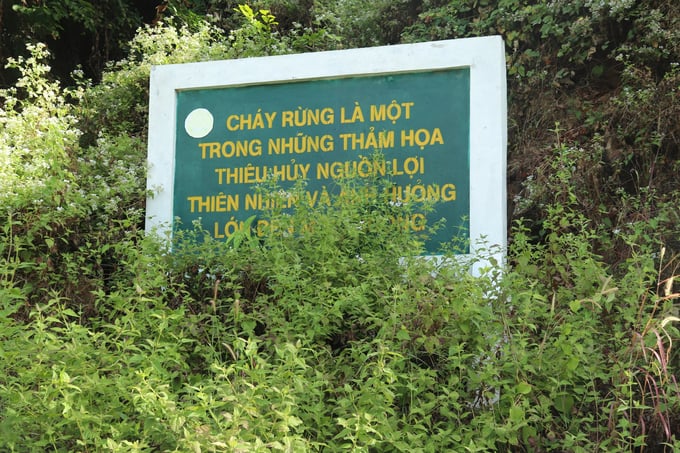
The propaganda work on forest fire prevention on Hon Khoai island receives special attention. Photo: Mai Phuong.
The most "leisurely" time for rangers on Hon Khoai island is the rainy season months. During the rainy season, rangers on Hon Khoai island can take advantage of each other to visit home once a month. In the dry season, the chance to visit home for forest rangers on Hon Khoai island is considered "luxury"; it takes 2-3 months for them to visit home once, and all the time is focused on forest fires prevention.
“During the rainy and stormy season, the pressure on forest fires has decreased, but the responsibilities of forest rangers focus on coordinating with units stationed on the island to organize patrols at sea to be ready to rescue fishermen's fishing boats that are in trouble at sea, especially in cases where fishing boats sink due to strong waves and winds," shared Mr. Huynh Tuan Kiet, the District Head of the Forest Ranger Department of Hon Khoai island cluster.
Translated by Bao Ngoc

(VAN) The People's Committee of Tra Vinh province has approved an adjustment to the investment policy for the Green Hydrogen Plant project, increasing its area to approximately 52.76 hectares.
![Reducing emissions from rice fields: [2] Farmers’ commitment to the soil](https://t.ex-cdn.com/nongnghiepmoitruong.vn/608w/files/news/2025/05/05/dsc08881jpg-nongnghiep-140632.jpg)
(VAN) Clean rice cultivation model in Thuong Tan commune, Bac Tan Uyen district, is assisting local residents in achieving sustainable agriculture by substantially reducing costs, increasing productivity, and protecting the environment.

(VAN) At the conference to disseminate Resolution No. 68, AgriS introduced its digital agricultural ecosystem and reaffirmed its commitment to accompanying the Government in promoting private sector development and sustainable agriculture.

(VAN) 'Blue Ocean - Blue Foods' initiative is designed to restore marine ecosystems and establish sustainable livelihoods for local communities by cultivating a minimum of 1,000 hectares of cottonii seaweed in the first three years.
/2025/05/21/4642-3-112707_603.jpg)
(VAN) The V-SCOPE project has made direct contributions to three out of six pillars of the Comprehensive Strategic Partnership between Vietnam and Australia.

(VAN) Facing the threat of rabies spreading to the community, Gia Lai province urgently carries out measures to vaccinate dogs and cats on a large scale.

(VAN) Disease-free livestock farming not only protects livestock herds but also stabilizes production and livelihoods for many farmers in Tuyen Quang.